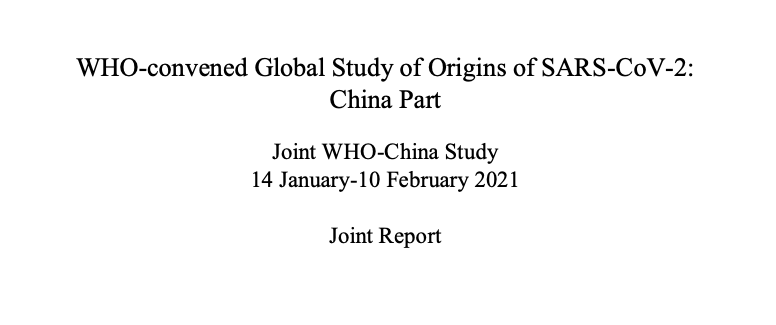
Did the virus originate in the Wuhan lab?
Geneva: The World Health Organisation (WHO) today called for further studies to trace the origin of COVID-19 virus and said the source of the virus was yet not found. “…all hypotheses remain on the table”, WHO Director-General Dr. Tedros Adhanom Ghebreyesus said as the report of the international team on their Wuhan field visit, from January 14 to February 10, 2021 and worked with scientists there, was published today.
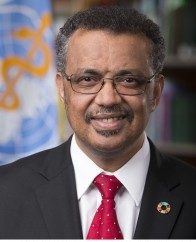
Dr. Ghebreyesus said that while the team reported that the first detected case had symptom onset on the December 8, 2019, it needed “full access” to data including biological samples from at least September 2019 to understand the earliest cases. However, he revealed that “in my discussions with the team, they expressed the difficulties they encountered in accessing raw data”.
The WHO-DG’s statement assumes significance in the light of the ostensible hurdles created by China to delay the visit of the scientific team. What makes the case even more conspicuous is the hurry in which the team gave a clean chit to China even before leaving its shore after the study, stating that possibility of coronavirus emerging from lab, what many had suspected, is “extremely unlikely”. The Chinese lead in the WHO team then asserted that the virus was circulating earlier in “other regions”
Given his relationship with China, which was his important ally during WHO Director-General’s election in 2017, Dr. Ghebreyesus statement today draws further attention for many reasons.
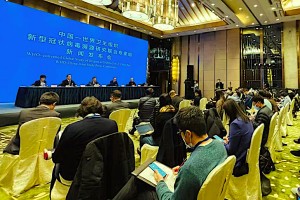
It is significant that the report stems from a Member State resolution adopted by consensus at the World Health Assembly in May 2020 and calling on WHO “to identify the zoonotic source of the virus and the route of introduction to the human population, including the possible role of intermediate hosts, including through efforts such as scientific and collaborative field missions.” In fact only a few weeks into the outbreak, the International Health Regulations Emergency Committee of independent experts had recommended that WHO and China pursue efforts to identify the animal source of the virus. However, throughout 2020, WHO just had discussions with China and other Member States the need to study and share information around the virus origins, though the Terms of Reference for the Virus Origins Study were completed by fall 2020.
The fact remains that ever since the pandemic started, much explanation had also been sought from Dr. Ghebreyesus about the ongoing research on the virus. It may be recalled that in July last year itself the then US Secretary of State, Mike Pompeo had gone to the extent of saying that he believed the results of the inquiry would be “completely whitewashed”.
What had raised further eyebrows were the inability of the two-member team tasked with investigating the origins of coronavirus to visit Wuhan – where the first case of COVID-19 were traced at a sea food market in December 2019. In July 2020 WHO sent a small team to China to plan a joint study comprising Chinese and independent international scientists. The WHO team remained in Beijing for three-weeks, which made the USA, Australia and some Western countries, on one hand question Beijing’s commitment to identifying the source of the pandemic, and on the other, accuse the WHO of going soft on China for very obvious reasons. Even after that, China continued to delay further visit by international scientists to study the origins of Coronavirus, and finally when the team reached China on January 14, 2021, it was quarantined for two weeks.
Also read:
- WHO’s expert team in Wuhan says possibility of coronavirus emerging from lab is ‘extremely unlikely’
- WHO team reaches Wuhan; to be in quarantine for two weeks
- China continues to delay visit by international scientists to study the origins of Coronavirus, WHO D-G tells member states
- Armed with successful vaccine trials and G-20’s financial support, WHO seeks to get rid of its pro-China tag
- Why shouldn’t WHO D-G attack the USA at the UNGA?
- International Council of Jurists moves UNHRC against China for COVID-19 reparations
Today, even as the WHO D-G claimed that he expects future collaborative studies to include more timely and comprehensive data sharing, Dr. Ghebreyesus’ argument on the perceptible failure of the team to trace the origin of the virus in China was that “finding the origin of a virus takes time and we owe it to the world to find the source so we can collectively take steps to reduce the risk of this happening again. No single research trip can provide all the answers.”
His statements today were quite revealing in the light of earlier statements made by the team. Consider what Dr. Peter Ben Embarek from the WHO had told reporters on February 9, 2021 in Beijing: “…the findings suggest that the laboratory incident hypothesis is extremely unlikely to explain introduction of the virus into the human population, and therefore is not a hypothesis that implies to suggest future studies into our work, to support our future work, into the understanding of the origin of the virus.”
Compare this with what Dr. Ghebreyesus stated today: “The team also visited several laboratories in Wuhan and considered the possibility that the virus entered the human population as a result of a laboratory incident. However, I do not believe that this assessment was extensive enough. Further data and studies will be needed to reach more robust conclusions. Although the team has concluded that a laboratory leak is the least likely hypothesis, this requires further investigation, potentially with additional missions involving specialist experts, which I am ready to deploy.”
“It is clear that we need more research across a range of areas, which will entail further field visits,” he said while thanking the experts from around the world and China who participated in the report.
But there does appear more to it than meets the eyes considering what Ben Embarek told an interviewer from Science Magazine recently – “Yes. We had long meetings with the staff of the Wuhan Institute of Virology and three other laboratories in Wuhan. They talked about these claims openly… You need to do a formal audit, and that’s far beyond what our team is mandated to do or has the tools and capabilities to do.” Ben Embarek went on to tell the interviewer, Kai Kupfershmidt – “The politics was always in the room with us on the other side of the table (during the team’s visit to China). We had anywhere between 30 and 60 Chinese colleagues, and a large number of them were not scientists, not from the public health sector. We know there was huge scrutiny on the scientific group from the other sectors. So, the politics was there constantly. We were not naïve, and I was not naïve about the political environment in which we tried to operate and, let’s face it, that our Chinese counterparts were operating under.”
In his remarks to Member States today, Dr. Ghebreyesus, though, said that the report “advances our understanding in important ways, while raising questions that will need to be addressed by further studies”. He went on to say that this report “is a very important beginning, but it is not the end…”.
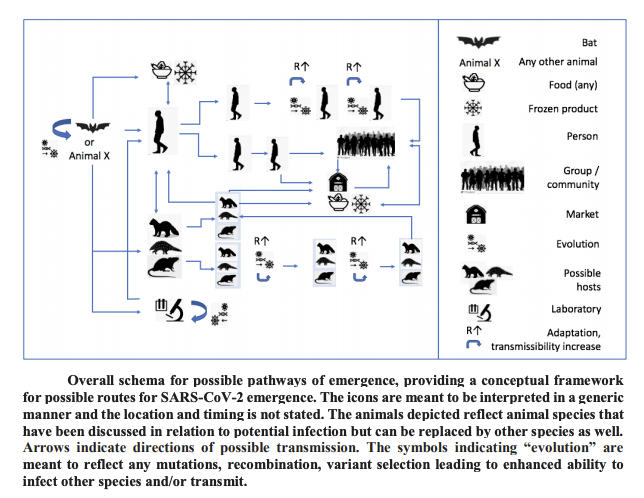
Still what is important are the recommendations made by the team of scientists for further studies to understand the earliest human cases and clusters, to trace the animals sold at markets in and around Wuhan, and to better understand the range of potential animal hosts and intermediaries. According to the report, the role of animal markets was still unclear. Dr. Ghebreyeus disclosed that the team had confirmed that there was widespread contamination with SARS-CoV-2 in the Huanan market in Wuhan, “but could not determine the source of this contamination”.
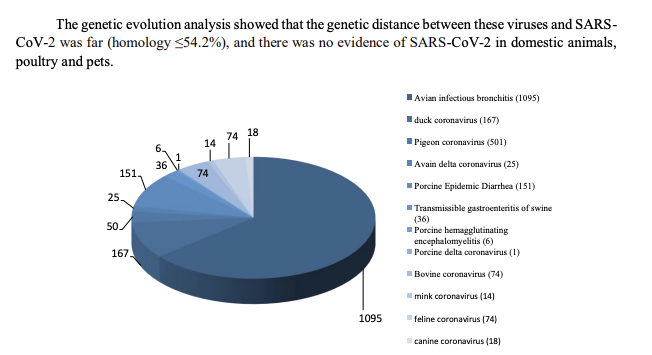
The team in the report further recommends further research, including a full analysis of the trade in animals and products in markets across Wuhan, particularly those linked to early human cases. The team also addressed the possibility that the virus was introduced to humans through the food chain and stated that further study will be important to identify what role farmed wild animals may have played in introducing the virus to markets in Wuhan and beyond.
“I concur with the team’s conclusion that farmers, suppliers and their contacts will need to be interviewed,” Dr. Ghebreyesus stated.
– global bihari bureau (with inputs from Deepak Parvatiyar)





